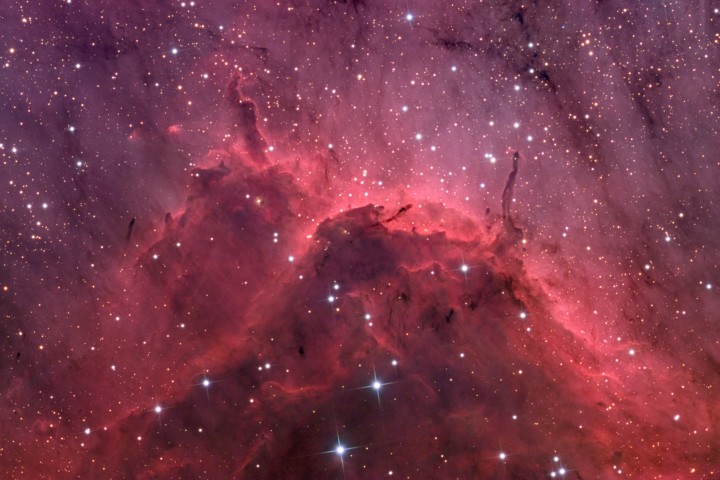Credit & Copyright: Russell Croman
Explanation:
This
amazing skyscape lies along a bright ridge of emission in
IC 5067, also known as
The Pelican Nebula.
Appropriately, the Pelican Nebula itself is part of a much larger,
complex star-forming region about 2,000 light-years away in
the high flying constellation
Cygnus, the Swan.
Cosmic dust clouds that span light-years seem to rise like mountains
in the mist in this natural color view, recorded through broadband
filters to produce an
analogy to human
color vision.
The fantastic shapes are sculpted by winds and
radiation from a hot, massive stars and the dominant
red emission is due to atomic hydrogen gas.
Placing your cursor on the image will bring up a false color image of
the
nebula made through narrowband filters that also map specific emission
from sulfur and oxygen atoms.
The mapped color image reveals even
more details of the cosmic
clouds and their composition.
1999 2000 2001 2002 2003 2004 2005 2006 2007 2008 2009 2010 2011 2012 2013 2014 2015 2016 2017 2018 2019 2020 2021 2022 2023 2024 2025 |
Январь Февраль Март Апрель Май Июнь Июль Август Сентябрь Октябрь Ноябрь Декабрь |
NASA Web Site Statements, Warnings, and Disclaimers
NASA Official: Jay Norris. Specific rights apply.
A service of: LHEA at NASA / GSFC
& Michigan Tech. U.
|
Публикации с ключевыми словами:
emission nebula - Pelican Nebula - эмиссионная туманность - Туманность Пеликан
Публикации со словами: emission nebula - Pelican Nebula - эмиссионная туманность - Туманность Пеликан | |
См. также:
Все публикации на ту же тему >> | |
